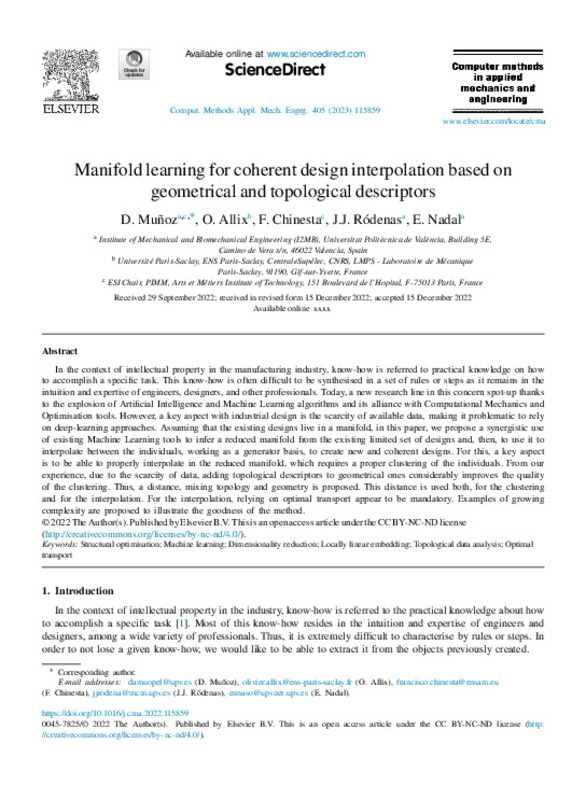JavaScript is disabled for your browser. Some features of this site may not work without it.
Buscar en RiuNet
Listar
Mi cuenta
Estadísticas
Ayuda RiuNet
Admin. UPV
Manifold learning for coherent design interpolation based on geometrical and topological descriptors
Mostrar el registro sencillo del ítem
Ficheros en el ítem
| dc.contributor.author | Muñoz-Pellicer, David
|
es_ES |
| dc.contributor.author | Allix, O.
|
es_ES |
| dc.contributor.author | CHINESTA SORIA, FRANCISCO JOSE
|
es_ES |
| dc.contributor.author | Ródenas, Juan José
|
es_ES |
| dc.contributor.author | Nadal, Enrique
|
es_ES |
| dc.date.accessioned | 2024-04-11T08:00:40Z | |
| dc.date.available | 2024-04-11T08:00:40Z | |
| dc.date.issued | 2023-02-15 | es_ES |
| dc.identifier.issn | 0045-7825 | es_ES |
| dc.identifier.uri | http://hdl.handle.net/10251/203340 | |
| dc.description.abstract | [EN] In the context of intellectual property in the manufacturing industry, know-how is referred to practical knowledge on how to accomplish a specific task. This know-how is often difficult to be synthesised in a set of rules or steps as it remains in the intuition and expertise of engineers, designers, and other professionals. Today, a new research line in this concern spot-up thanks to the explosion of Artificial Intelligence and Machine Learning algorithms and its alliance with Computational Mechanics and Optimisation tools. However, a key aspect with industrial design is the scarcity of available data, making it problematic to rely on deep-learning approaches. Assuming that the existing designs live in a manifold, in this paper, we propose a synergistic use of existing Machine Learning tools to infer a reduced manifold from the existing limited set of designs and, then, to use it to interpolate between the individuals, working as a generator basis, to create new and coherent designs. For this, a key aspect is to be able to properly interpolate in the reduced manifold, which requires a proper clustering of the individuals. From our experience, due to the scarcity of data, adding topological descriptors to geometrical ones considerably improves the quality of the clustering. Thus, a distance, mixing topology and geometry is proposed. This distance is used both, for the clustering and for the interpolation. For the interpolation, relying on optimal transport appear to be mandatory. Examples of growing complexity are proposed to illustrate the goodness of the method.(c) 2022 The Author(s). Published by Elsevier B.V. This is an open access article under the CC BY-NC-ND license (http://creativecommons.org/licenses/by-nc-nd/4.0/). | es_ES |
| dc.description.sponsorship | The authors gratefully acknowledge the financial support of Ministerio de Educacion, Spain (FPU16/07121),Generalitat Valenciana, Spain (Prometeo/2021/046 and CIAICO/2021/226), Ministerio de Economia, Industriay Competitividad, Spain (DPI2017-89816-R) and FEDER. O. Allix would like to thank the French National University Council and ENS Paris-Saclay for supporting his sabbatical at UPV, which made it possible to closely interact with the colleagues from I2MB-UPV. Funding for open access charge: CRUE-Universitat Politecnica de Valencia | es_ES |
| dc.language | Inglés | es_ES |
| dc.publisher | Elsevier | es_ES |
| dc.relation.ispartof | Computer Methods in Applied Mechanics and Engineering | es_ES |
| dc.rights | Reconocimiento - No comercial - Sin obra derivada (by-nc-nd) | es_ES |
| dc.subject | Structural optimisation | es_ES |
| dc.subject | Machine learning | es_ES |
| dc.subject | Dimensionality reduction | es_ES |
| dc.subject | Locally linear embedding | es_ES |
| dc.subject | Topological data analysis | es_ES |
| dc.subject | Optimal transport | es_ES |
| dc.subject.classification | INGENIERIA MECANICA | es_ES |
| dc.title | Manifold learning for coherent design interpolation based on geometrical and topological descriptors | es_ES |
| dc.type | Artículo | es_ES |
| dc.identifier.doi | 10.1016/j.cma.2022.115859 | es_ES |
| dc.relation.projectID | info:eu-repo/grantAgreement/AEI/Plan Estatal de Investigación Científica y Técnica y de Innovación 2013-2016/DPI2017-89816-R/ES/MODELADO PERSONALIZADO DE LA RESPUESTA DEL TEJIDO OSEO DE PACIENTES A PARTIR DE IMAGENES 3D MEDIANTE MALLADOS CARTESIANOS DE ELEMENTOS FINITOS/ | es_ES |
| dc.relation.projectID | info:eu-repo/grantAgreement/MECYD//FPU16%2F07121//AYUDA PARA CONTRSTOS PREDOCTORALES FPU-MUÑOZ PELLICER (PROYECTO: DESARROLLO DE TECNICAS HIBRIDAS DE OPTIMIZACION DE COMPONENTES MECANICOS MEDIANTE MALLADOS CARTESIANOS)/ | es_ES |
| dc.relation.projectID | info:eu-repo/grantAgreement/GENERALITAT VALENCIANA//PROMETEO%2F2021%2F046//MODELADO NUMÉRICO AVANZADO EN INGENIERÍA MECÁNICA/ | es_ES |
| dc.relation.projectID | info:eu-repo/grantAgreement/GENERALITAT VALENCIANA//CIAICO%2F2021%2F226//EMPLEO DE REDES NEURONALES INFORMADAS MEDIANTE PROCESOS FISICOS PARA LA SIMULACION NUMERICA DE PROBLEMAS EN BIOMECANICA/ | es_ES |
| dc.rights.accessRights | Abierto | es_ES |
| dc.contributor.affiliation | Universitat Politècnica de València. Escuela Técnica Superior de Ingeniería del Diseño - Escola Tècnica Superior d'Enginyeria del Disseny | es_ES |
| dc.description.bibliographicCitation | Muñoz-Pellicer, D.; Allix, O.; Chinesta Soria, FJ.; Ródenas, JJ.; Nadal, E. (2023). Manifold learning for coherent design interpolation based on geometrical and topological descriptors. Computer Methods in Applied Mechanics and Engineering. 405. https://doi.org/10.1016/j.cma.2022.115859 | es_ES |
| dc.description.accrualMethod | S | es_ES |
| dc.relation.publisherversion | https://doi.org/10.1016/j.cma.2022.115859 | es_ES |
| dc.type.version | info:eu-repo/semantics/publishedVersion | es_ES |
| dc.description.volume | 405 | es_ES |
| dc.relation.pasarela | S\481011 | es_ES |
| dc.contributor.funder | GENERALITAT VALENCIANA | es_ES |
| dc.contributor.funder | MINISTERIO DE EDUCACION | es_ES |
| dc.contributor.funder | AGENCIA ESTATAL DE INVESTIGACION | es_ES |
| dc.contributor.funder | European Regional Development Fund | es_ES |
| dc.contributor.funder | Universitat Politècnica de València | es_ES |
| dc.contributor.funder | École Normale Supérieure Paris-Saclay | es_ES |
| dc.contributor.funder | Conseil National des Universités, Francia | es_ES |








